







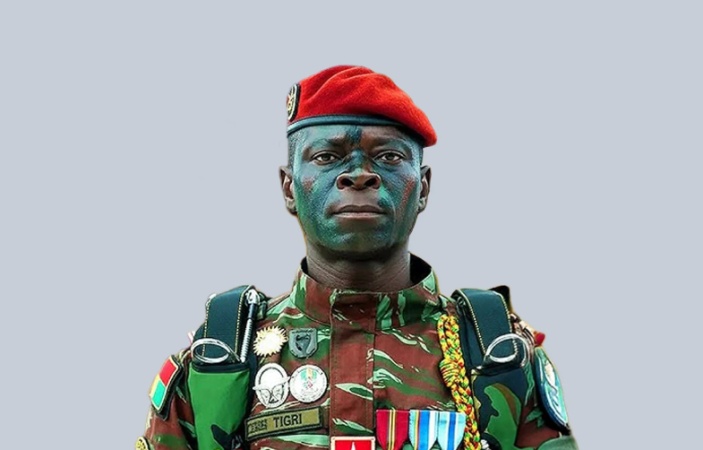




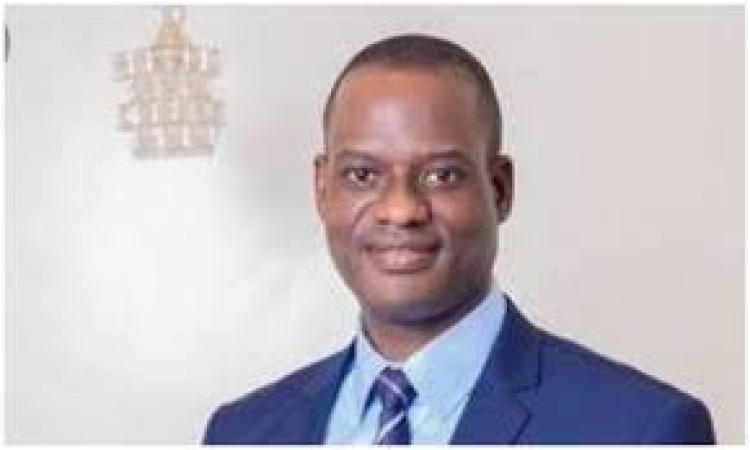
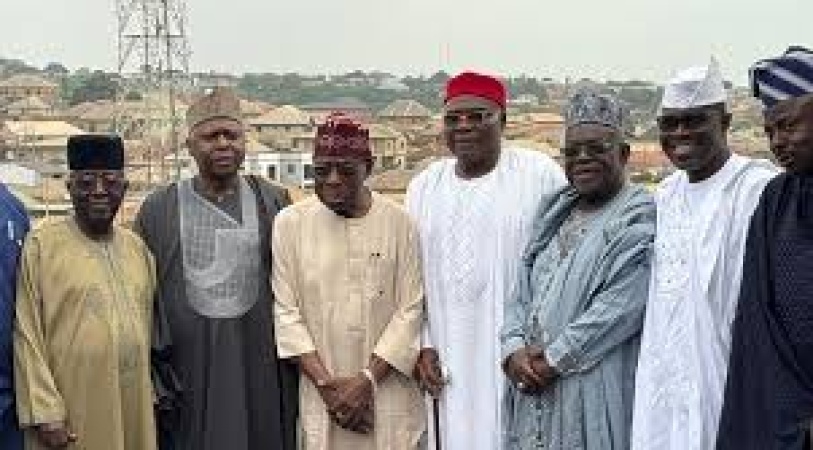


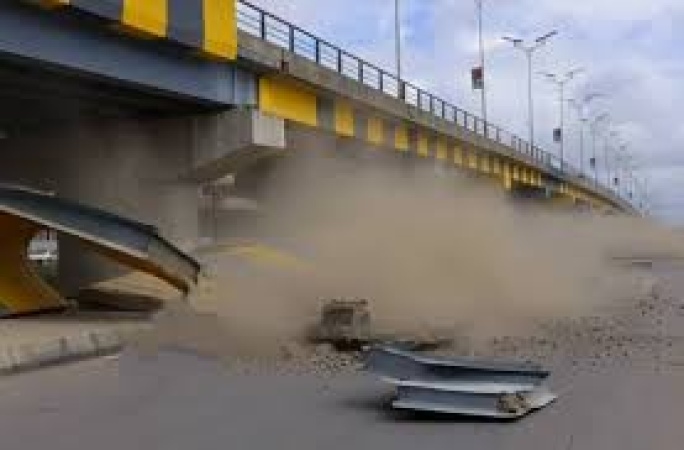



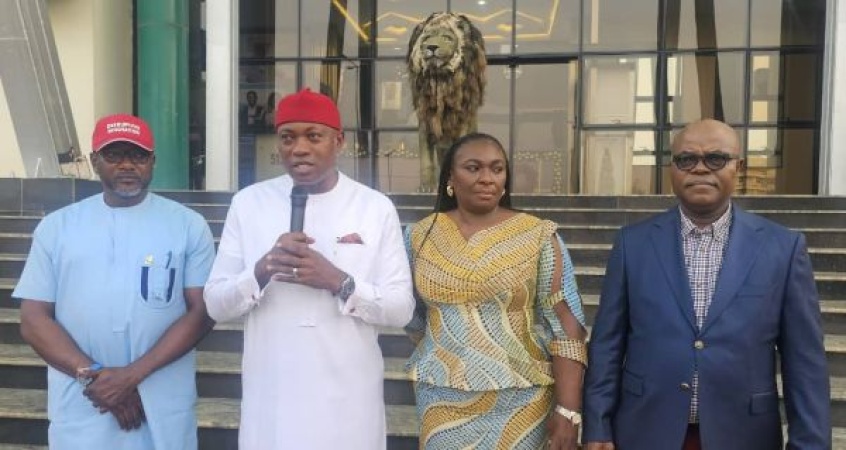
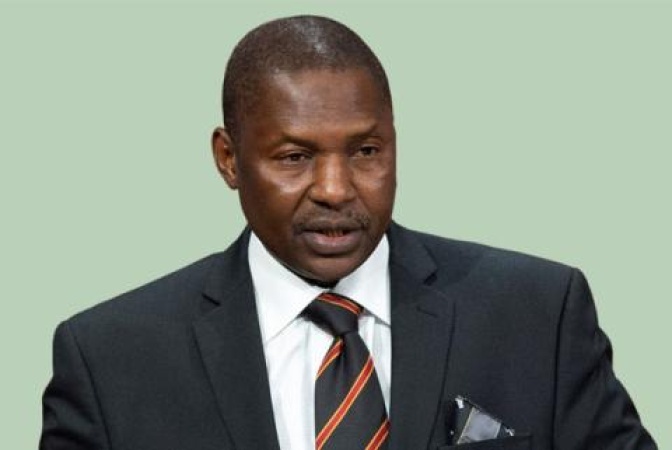



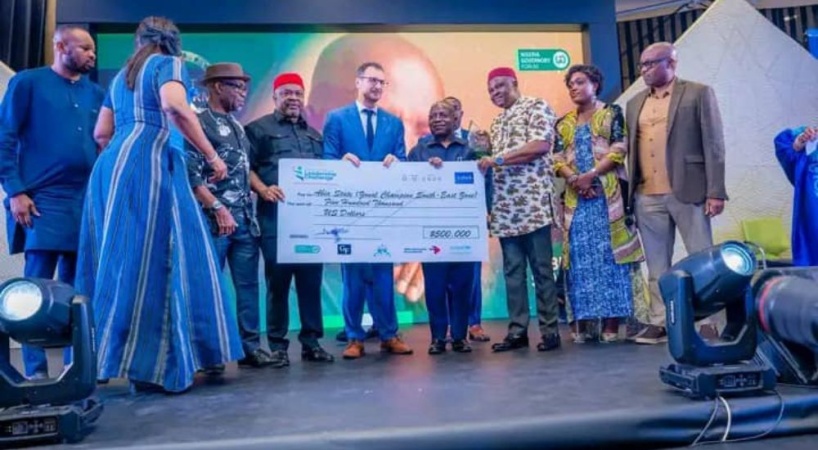

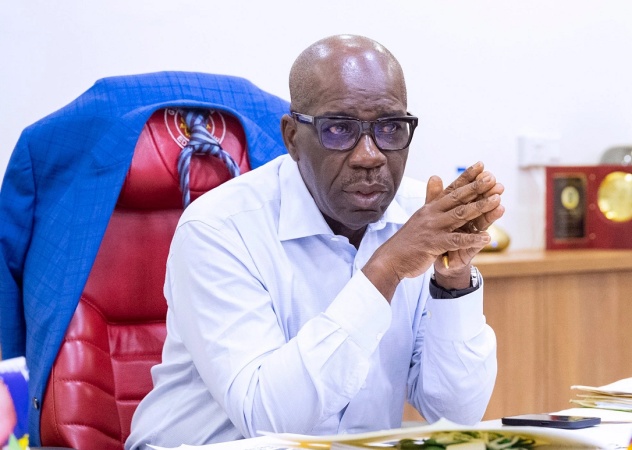

Loading banners


NEWS EXPRESS is Nigeria’s leading online newspaper. Published by Africa’s international award-winning journalist, Mr. Isaac Umunna, NEWS EXPRESS is Nigeria’s first truly professional online daily newspaper. It is published from Lagos, Nigeria’s economic and media hub, and has a provision for occasional special print editions. Thanks to our vast network of sources and dedicated team of professional journalists and contributors spread across Nigeria and overseas, NEWS EXPRESS has become synonymous with newsbreaks and exclusive stories from around the world.

China is home to six out of the 10 largest battery makers in the world Credit: Alamy
In 2005, China only had two EV battery manufacturers. Twenty years later, it produces more than three-quarters of the world?s lithium-ion cells. How did it happen?
At the 2008 Beijing Olympics, athletes, journalists and officials from all over the world were transported by a fleet of sleek buses sporting a white, blue and green design as they zipped between different venues in the Chinese capital.
Different from the diesel-powered vehicles that ruled Beijing?s streets at the time, the Olympic buses, numbering around 50, ran on lithium-ion batteries to help Beijing host a ?green and high-tech? Olympic Games. It also marked the country?s first foray into creating a lithium-ion battery industry for electric vehicles (EVs), laying the groundwork for China?s ascension to world leader of this technology two decades later.
The Olympic e-bus campaign had been set in motion as soon as Beijing won the bid in 2001, according to a 2020 documentary aired by China?s state media. But developing and producing EV batteries for the global event was no easy feat.
In late 2003, Mo Ke and his colleagues at the Beijing New Materials Development Centre ? a government-affiliated research institute ? were tasked to analyse China?s lithium battery industry as part of Beijing?s preparatory work for the Olympics.
But back then, China?s lithium battery industry was ?very small? with only two EV battery producers, as Mo?s team found. In 2005, they hosted China?s first conference for the lithium battery industry as a part of their research.
?All companies in the industry came, but there were only around 200 people in total,? Mo says.
At the time, CATL, the world?s current largest EV battery maker, was a department of ATL, a Japanese-owned company that made lithium batteries for electronic gadgets. BYD, the world?s current second-largest EV battery maker and a leading EV maker, had just entered the auto industry after earning its first barrel of capital by supplying batteries to phone giants.
Twenty years later, China is the king of the industry indispensable to the world?s 2050 net-zero goal. It produces more than three-quarters of all lithium-ion batteries worldwide and is home to six out of the 10 largest battery makers on the planet.
What led to its meteoric rise? The answer lies in a combination of factors.
Two of them are a huge domestic market ?walled off and preserved? for local firms and coordinated government support across the supply chain, says Xie Yanmei, an independent analyst of Chinese political economy and industrial policy. Consumer subsidies, state-sponsored rollout of charging networks and a policy mandating automakers to make EVs also helped, she notes.
But policy is only part of the story. Chinese companies also proved adept at large-scale production and controlling cost ? both key to EV battery manufacturing.
?They have strong survival instinct and will proactively explore new ideas to help them stay competitive,? says Song Xin, who advises Chinese companies ranging from car to robot makers aiming to go global. ?This is the foundation of the industry?s continuous growth.?
International roots
The story of lithium batteries began beyond China?s shores about 50 years ago with three chemists: British-American Stanley Whittingham, American John Goodenough and Japanese Akira Yoshino.
Their separate research ? which earned them a joint Nobel Prize in 2019 ? rode on each other?s strength and led to the invention of the first commercially viable lithium-ion battery in 1985, built by Yoshino for Tokyo-based chemical company Asahi Kasei.
In 1991, Japanese electronics company Sony worked with Asahi Kasei to bring the world?s first lithium-ion batteries to the market. Five years later, Nissan teamed up with Sony to launch the world?s first car powered by a lithium-battery.
In the following decade, Japan was the global number one lithium-ion battery producer, with South Korea keenly vying for supremacy. At the turn of the century, Japanese firms accounted for a staggering 93% of the global market share, with electronics company Sanyo leading the charge. It wasn?t until 2011 that South-Korean Samsung SDI overtook Japanese Panasonic to top the chart.
Chinese policy makers decided that EVs could be an opportunity for the Chinese auto industry to leapfrog the west ? Xie Yanmei
When Mo was researching China?s lithium battery industry in the early 2000s, Mengguli and Wanxiang were the only two companies making EV batteries in the country.
?They supplied most of the batteries for the e-buses that served the Beijing Olympics and the World Expo in Shanghai in 2010,? says Mo, now the founder and chief analyst of Chinese battery-research firm, RealLi Research.
But before the Olympics, China had already planned a long game. In 2006, its cabinet launched a science and technology scheme that would cover the next 15 years. It included ?low-emission and new-energy vehicles [NEVs]? as one of the 62 priority areas the country should pursue, and listed ?rechargeable power battery? as a key technology for this area. NEVs, a term frequently used by the Chinese government, refers to pure electric, plug-in hybrids, and fuel cell vehicles powered by alternative fuels such as hydrogen and methanol.
China?s goal was clear: to upgrade its vast manufacturing industry by 2020 so that it would stop relying on cheap labour and start winning with technological advantages.
In 2009, with a smooth run of the Olympics e-buses in the bag, China made a major move to ?adjust and revitalise? its auto industry.
For years, Beijing had tried but failed to be a global contender in the conventional auto industry that featured internal combustion engines. But it believed it was time for a reboot.
?Chinese policy makers decided that EVs could be an opportunity for the Chinese auto industry to leapfrog the west, because it was like a blank field where everybody was starting from scratch,? says Xie.
A national plan guided regional governments to build supply chains and charging networks for NEVs. It also supported domestic companies to spearhead the research and development of technologies related to EVs, including batteries.
In the same year, the country began its large-scale rollout of new-energy buses, with the ?10 Cities and Thousand Vehicles? programme.
Sluggish American competition
In Mo?s view, China?s determination to promote EVs was vital for its battery ascension, and that vision was partly inspired by the US.
The US saw a wave of interest in developing and making battery-powered vehicles first during the 1970s after the breakout of the oil crisis, and then again in the 1990s after the federal government published a regulation to tackle air pollution.
As early as 1990, California launched a zero-emission vehicle (ZEV) programme to improve air quality by encouraging the adoption of EVs. The programme led to the introduction of ZEV mandate, which essentially forced car companies like General Motors to invest in EVs, says Anders Hove, senior research fellow at the Oxford Institute for Energy Studies in the UK.
Actions on the other side of the ocean led the Chinese government to realise that EVs were ?a stepping stone? to what was later described as the ?fourth industrial revolution? ? an era characterised and driven by digital technologies ? and China wanted a place in it, according to Mo.
But the EV push by California did not lead to the establishment of a US lithium-ion battery industry, partly because car and oil companies lobbied California to ?water down? the ZEV mandate to give more support for fuel cells powered by hydrogen and hybrid cars, whose batteries used non-lithium chemistries, Hove says.
In the 2000s, the George W Bush administration introduced measures to fund the research and development of EVs. US startups made major progress on both batteries and cars, Hove says, but then came the financial crisis in 2008.
?[The first wave of US startups] all ran into a lot of financial difficulty and the window kind of closed on investing in clean energy,? Hove says. ?All the people who had invested in that, they were burned.?
In the following year, the Obama administration launched a new round of funding, but it was too late to save that first wave of renewable companies from collapsing or selling their technologies, Hove says. Many of them were bought by Chinese firms, according to him, including battery company A123, a rising-star that boasted advanced lithium-ion battery technology developed at MIT. A123 was acquired by China?s Wanxiang in 2013.
At the same time, China launched an enormous four-trillion-yuan (roughly ?394bn or $649bn then) stimulus plan to counter the impact of the global financial crisis and part of it was directed towards ?energy-saving and emissions-reduction? projects. The move ignited the country?s interest in renewable technologies, including NEVs, according to a 2010 report published by the World Wide Fund for Nature (WWF) and China?s Research Institute of Resources and Environment Policies.
China?s industry snowballs
The years between 2012 and 2020 proved to be critical for China?s battery makers as the government doubled down its effort in putting EVs on the road.
An Industrial roadmap for new-energy vehicles set targets on the number of EVs the country should deploy over the period. More importantly, it also set technical requirements for EV and battery manufacturers to apply for state support ? a push for them to grow. In 2013, China made EV purchase subsidies available to individual consumers, not just the public sector, opening the floodgate to private car ownership.
The scale of the state backing was enormous. In 2014, China?s central and regional governments spent nearly 10bn yuan (roughly ?986m or $1.6bn then) on subsidies, according to a report at the time. Over the next eight years, the country would go on to hand out 200bn yuan (?21bn or $28bn) in tax rebates in total for new-energy vehicles.
The investment yielded almost instant result. Both the number of NEVs produced and sold in the country grew more than threefold in 2014 and 2015, according to the China Association of Automobile Manufacturers, a trade body. Their market share would snowball from 1.3% in 2015 to 41% in 2024.
More like this:
? How scooters are driving China?s salt battery push
? Battery swaps: China?s alternative to plug-in EVs
? The liquid air alternative to fossil fuels
But a bigger boost for the battery industry was yet to arrive. In 2015, China introduced a key rule that ? in Xie?s words ? ?walled off? its huge domestic market for Chinese battery firms. EV makers were mandated to use batteries produced by one of the selected suppliers if their cars were to qualify for consumer subsidies. All of the 57 companies that appeared on a government ?white list? turned out to be Chinese.
?It was very cleverly designed technical specifications that narrowly defined that only Chinese battery companies would be eligible,? Xie says. At that time, some South Korean companies had already started building factories in China, ?only to find out that they were completely shut out the market?, she adds.
Those Chinese EV makers that had been using foreign suppliers had to make a last-minute switch to battery manufacturer CATL and few other domestic firms complied with the policy, The Economic Observer reported. That rule ended up lasting four years.
In the fast lane
A sudden influx of new customers propelled CATL ? which split from ATL in 2011 ? to become the world?s largest EV battery producer in 2017, based in Ningde, China, beating Panasonic and its compatriot BYD, Chinese news site Caixin reported. CATL has held the title since.
The policy drive continued with the ?Made in China 2025? strategy, which aimed at helping the country ?grab the global vantage point for manufacturing? by the mid-2020s through technological innovation. NEVs were listed as a ?key area? the country should ?vigorously promote?.
Riding on the momentum, China introduced a ?dual-credit? system for automakers in 2017. Partly based on California?s ZEV programme, the policy essentially demanded that all automakers in China produce EVs to ?balance off? the conventional cars they made through a complex formula. A ?one-way street? design pushed automakers to make more EVs in order to avoid unnecessary cash spending.
?As an automaker, on the one hand, you had to produce EVs in China or face a [financial] penalty. On the other, the EVs you were forced to produce would not sell without Chinese batteries,? Xie explains. ?So, every automaker, Chinese, Korean, Japanese, Americans, Germans, had to use Chinese batteries.?
The ballooning and protected market allowed CATL to work with advanced Western car makers on joint innovation. The process ?quickly brought up its skill and capability?, Xie adds.
The way China's EV and battery industries grew was also fundamentally different from the West. The key was the close partnership between the government and the industry, says Song, founder of Sinnvoll Global Strategy, a think tank with offices in Beijing and Berlin.
The government's massive investment had come with a clear goal: to build a strong EV manufacturing industry. And that goal was delivered via fierce competition within the industry to decide which companies or technologies would survive and thrive, according to Song.
This method ? like running rounds and rounds of industrial-wide ?horse races? to pick the fastest ? is much more effective than the conventional model in Europe, North America and Japan, where industrial growth is often driven by few major companies or consortiums, she explains. ?This also means that China can bring a technology from the lab to mass production very quickly.?
Secrets to success
There are other important elements that set China?s battery industry apart. ?It?s the supply chain, know-how and manufacturing,? says Taylor Ogan, chief executive of Shenzhen-based Snow Bull Capital, which invests in China?s clean-tech sector.
For one, top Chinese battery makers, such as CATL and BYD, run on a ?vertically integrated? business model, which means that they often own their suppliers fully or partly.
?This helps control cost and ensure the security and reliability of their supply chains,? says Chen Shan, a Shanghai-based analyst on battery markets at Norwegian consultancy Rystad Energy.
Their capability at managing large-scale manufacturing matters enormously, too.
?Modern EV battery packs string hundreds of small cells side by side or end by end. One weak cell would drag down the whole chain, cut range and raise safety risks,? explains Liu Chengguang, who researches battery materials in Xi?an Jiaotong-Liverpool University in China. ?Every cell must be almost identical.?
Achieving the feat ?demands massive, highly automated plants with strict process control and real-time testing and smart sorting,? he notes.
This is precisely the strength of CATL, which grabbed nearly 40% of the global EV battery market in 2024, more than double second-place BYD.
?The secret to CATL?s success is that it can use less money to make better batteries while maintaining a huge manufacturing capacity,? according to Cheng Manqi, a journalist with Chinese business outlet Late Post, who has investigated the firm.
Constant innovation is another factor helping Chinese battery makers stay ahead of the game. For example, BYD?s signature ?blade battery?, a lithium-iron-phosphate (LFP) battery, was launched in 2020 partly because it was cheaper to make: the battery did not use cobalt, a mineral for which China had to rely on imports. But BYD significantly improved the performance of previous LFPs, making them more powerful, safer and smaller. It became so popular that it altered the prevailing type of lithium-ion battery in China.
Chinese batteries are cheaper, they are high-performing, they are available ? Francesca Ghiretti
Behind such a rapid tech revolution is a large pool of Chinese battery engineers, who came through a targeted education and vocational training system offered by colleges, universities and battery companies.
?Chinese companies have a generation of incredibly skilled technical researchers,? says Cory Combs, head of critical mineral and supply chain research at consultancy Trivium China.
?They are not just PhDs who work upstream in the lab. They?re not just floor workers in the factories,? says Combs. They are ?practicing engineers?, who know the production processes thoroughly, understand what the market wants and can use their knowledge to improve existing technology quicky to win consumers. ?That?s what you need to make batteries cost effective to produce,? he says.
CATL employs more than 20,000 technical engineers while BYD?s battery arm, FinDreams Battery, has more than 10,000 of them.
Can China maintain its dominance?
Today, China dominates the production at every stage of the battery supply chain, apart from the mining and processing of some raw minerals, according to the International Energy Agency. It is home to nearly 85% of the battery production capacity globally, compared to North America?s 5% and Europe?s 7%, according to research by consultancy Wood Mackenzie, seen by the BBC.
A consensus among researchers is that it will be extremely difficult for other countries to challenge China?s dominance over the current generation of battery technologies.
?Some aspects that led to China?s leadership, such as the existence of industrial clusters and vertical integration of supply chains, will be difficult to replicate,? says Kate Logan, a director at Asia Society Policy Institute who focuses on China?s climate and clean energy policies.
The fact that Chinese companies have already achieved scale manufacturing batteries and are expanding its production overseas is another huge hurdle for perspective competitors.
?Chinese batteries are cheaper, they are high-performing, they are available,? says Francesca Ghiretti, a researcher on China and economic security at RAND Europe, a non-profit research organisation. China?s production scale ?makes it really difficult for others to catch up ? not to catch up with the technology, but the commercial success of that technology,? she says. (BBC)